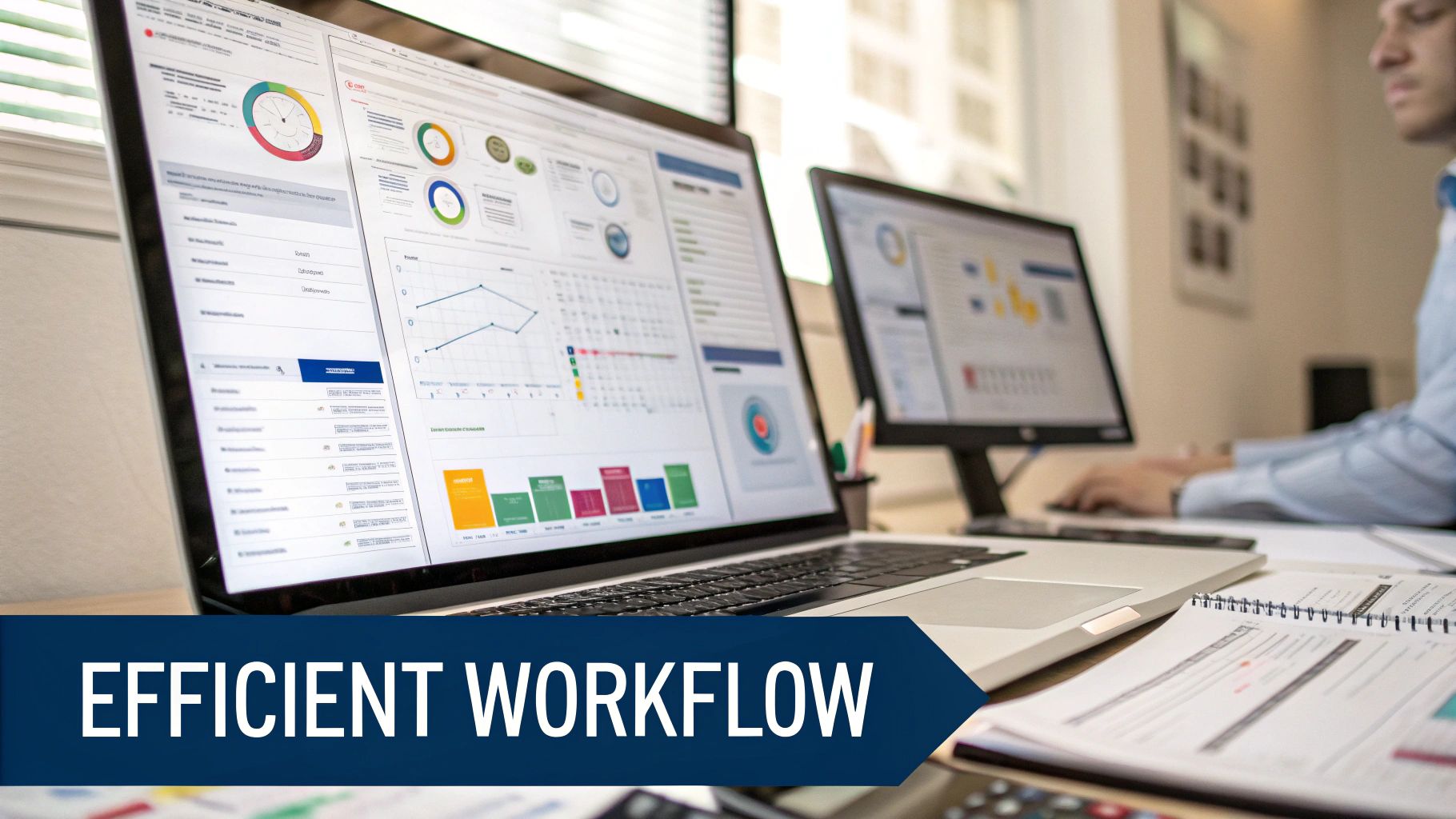Document Management System: Maximize Efficiency
The Evolution of Document Management: From Filing Cabinets to the Cloud

The way businesses manage documents has changed drastically. For decades, the filing cabinet was the standard. While functional, this system had limitations regarding accessibility, security, and scalability. Relying on physical storage created workflow bottlenecks, hindering productivity and increasing costs. The rise of digital technology changed everything, paving the way for the modern document management system.
One significant step in this evolution was the late 19th-century invention of the vertical filing system. This innovation revolutionized document organization, becoming the norm for much of the 20th century. However, as information grew, the limits of physical storage became clear. Learn more about this history here: A History of Document Management. This led to the adoption of electronic document management systems (EDMS) in the 1980s.
The Rise of Digital Solutions
The shift to EDMS significantly improved efficiency and accessibility. Businesses drastically reduced storage costs and improved retrieval times. Employees no longer spent valuable time searching through physical files. Early EDMS also laid the groundwork for improved security and version control. This spurred the development of more advanced features, further improving document management systems.
Cloud-Based Document Management: A New Era
The next major advancement was cloud-based document management systems. These offer increased flexibility and accessibility, allowing authorized users to access documents from anywhere with an internet connection. This eliminated the need for expensive on-site servers and IT infrastructure, reducing overhead. Cloud-based systems also offer better security, including encryption and access controls. The journey from filing cabinets to the cloud has been full of new solutions. Many document management systems are available now, and it's important to understand their differences. Explore some of the best document management systems. You can also learn more best practices here: How to master document management.
The Future of Document Management
Document management systems continue to evolve, integrating artificial intelligence and machine learning to automate processes and improve efficiency. Businesses can use these systems to streamline workflows, improve collaboration, and gain valuable insights from their data. These advancements are shaping the future of document management, helping organizations unlock the full potential of their information.
Game-Changing Features of Modern Document Management Systems

What separates a truly effective document management system from a simple digital filing cabinet? It's the features that empower businesses to take control of their information. These features aren't just about convenience; they fundamentally change how organizations operate. Think about the difference between rummaging through physical files and instantly retrieving a document with a keyword search. That leap in efficiency is the core value of a modern document management system.
Intelligent Document Capture and Organization
Modern document management systems go beyond basic storage. They use intelligent document capture, automatically pulling key information from documents, regardless of the format. This might involve scanning paper invoices, processing email attachments, or importing data from other business applications like Microsoft SharePoint. It’s like having a digital assistant that automatically sorts and labels your files. This automation drastically reduces manual data entry and ensures consistency.
This leads to improved organization. Robust metadata tagging and indexing give granular control over how documents are categorized and retrieved. Imagine a library where every book is meticulously cataloged – that's the level of organization a good system offers. This precise control is vital for quickly finding information, even in massive repositories. Systems have even incorporated barcodes for automated scanning and processing, further streamlining workflows. Learn more about the history of document management here.
The following table summarizes the essential features you should look for in a Document Management System:
Essential Features of Document Management Systems
Comparison of core features across basic, intermediate, and advanced document management solutions
| Feature Category | Basic DMS | Intermediate DMS | Advanced DMS |
|---|---|---|---|
| Document Capture | Manual Upload | Automated Capture from Email/Scanners | Intelligent Capture with OCR & Data Extraction |
| Storage & Organization | Basic Folder Structure | Metadata Tagging & Indexing | Automated Classification & Version Control |
| Search & Retrieval | Keyword Search | Advanced Search Filters | Full-Text Search & Content Analytics |
| Workflow Automation | Basic Approval Workflows | Customizable Workflows & Notifications | Integration with other Business Systems |
| Security & Access Control | Basic User Permissions | Granular Access Controls & Audit Trails | Advanced Encryption & Compliance Features |
As you can see, the more advanced the system, the more control and automation it provides. Choosing the right system for your needs is critical for success.
Automated Workflows and Collaboration
These systems also facilitate efficient collaboration. Automated workflows route documents through approval processes, eliminating manual handoffs and bottlenecks. Instead of emailing documents back and forth, a document can automatically move from creation to review to approval within the system. This speeds up processes and reduces errors.
Furthermore, version control tracks every document modification. This is critical for collaborative projects, ensuring everyone works with the latest version, eliminating confusion, and maintaining a clear audit trail. This feature is invaluable for document integrity and accountability.
Granular Security and Compliance
Security is paramount. Modern document management systems offer granular access controls, allowing administrators to define precisely who can access, edit, or share specific documents. It's like a digital vault with multiple security clearances, protecting sensitive information.
These systems also support compliance with industry regulations. Features like audit trails and retention policies help organizations meet requirements. This is especially important for industries like healthcare and finance, where compliance is essential. A comprehensive document management system simplifies meeting these requirements.
Advanced Search and Retrieval
Finding information quickly is essential. Modern systems provide robust search functionality. Users can locate documents based on keywords, metadata, or even the full text within documents. This is vastly more efficient than manual searches. The ability to quickly access relevant information makes employees more efficient. This enhanced searchability is a key benefit of modern document management systems.
The ROI Reality: Measuring Document Management System Success

Implementing a document management system (DMS) is a significant investment. Understanding its success and demonstrating a return on investment (ROI) is crucial. This goes beyond setup and focuses on the tangible benefits a DMS offers. For instance, studies show businesses can reduce document processing costs by 67% with an efficient DMS.
This is compelling, but understanding the contributing factors is key.
Quantifying the Benefits of a DMS
DMS ROI manifests in various ways across departments. Finance teams often see immediate impacts, streamlining invoice processing, reducing errors, and minimizing late fees. Legal departments can cut compliance risks by up to 80% with secure storage and automated retention policies.
For remote teams, a well-implemented DMS can boost collaboration speed by 3.5x, enhancing productivity and communication. This highlights the broad impact of a robust DMS.
To illustrate the various benefits and their impact, let's look at the following table. It outlines key ROI metrics and typical improvements seen after DMS implementation.
| Metric | Average Improvement | Timeline | Business Impact |
|---|---|---|---|
| Document Retrieval Time | 80% faster | Immediate | Increased staff productivity |
| Storage Costs | 50% reduction | Short-term | Reduced physical space and associated expenses |
| Compliance Risk | 80% reduction | Short-term | Lower risk of penalties and legal issues |
| Processing Costs | 67% reduction | Mid-term | Streamlined operations and improved efficiency |
| Collaboration Speed | 3.5x faster | Ongoing | Enhanced teamwork and communication |
This table summarizes how tracking various metrics demonstrates DMS value to stakeholders. Choosing the right metrics is essential for showcasing success.
Immediate Cost Savings vs. Long-Term Strategic Advantages
Some savings are immediate, like reduced paper use. However, the true value of a DMS often lies in its long-term strategic advantages. These include better decision-making with readily accessible information, enhanced customer service through quick responses, and increased agility in adapting to markets.
A company might not see the full impact of improved knowledge management for months after implementation. Yet, this advantage can significantly improve innovation and market responsiveness.
Calculating Your Potential ROI
Calculating potential DMS ROI requires assessing your current document processes. Identify inefficiencies like manual data entry, lengthy approvals, or document retrieval difficulties. Then, estimate the time and cost savings a DMS can offer by automating these.
This assessment should also consider potential revenue gains from improved customer satisfaction and faster time-to-market. Factor in DMS costs, including implementation, training, and maintenance. This gives a more accurate ROI picture.
Benchmarks and Best Practices
Industry benchmarks provide valuable reference points for calculating potential ROI. Researching case studies from successful DMS implementations offers valuable insights. Focus on organizations similar to yours in size and industry.
Their experiences can guide which metrics to track and expected improvements. This comparative analysis informs your implementation strategy. Understanding best practices, such as phased rollouts and user training, maximizes success. Engage stakeholders to ensure the system meets their needs and foster adoption across the organization. This proactive approach sets the stage for long-term success.
By focusing on measurable results and understanding the long-term strategic advantages, organizations can effectively demonstrate the true ROI of their DMS investment. A well-implemented DMS is more than a cost-saving tool; it's a strategic asset that drives growth and improves overall efficiency.
Connecting the Dots: Integrated Document Management

A standalone document management system, while helpful, can isolate information within a complex organization. True power comes from integration: connecting the document management system with other core business systems. This creates a unified information ecosystem. Data flows seamlessly between departments, enhancing efficiency and collaboration.
Think of it as a network of roads connecting cities, enabling smooth transport of goods and people. An integrated document management system ensures information travels efficiently across the organization.
The Pitfalls of Isolated Systems
Isolated document management systems often lead to data silos. Different departments might use separate systems, creating redundancy, inconsistencies, and difficulty sharing information.
For example, a sales team might store customer contracts in their CRM (Customer Relationship Management) system, while the legal team uses a separate system for legal documents. This lack of integration hinders collaboration and can cause errors. It's like having different languages spoken in each city, making trade and communication difficult. Integrated document management systems act as a universal translator.
Creating Seamless Information Flows
Successful organizations prioritize integrating their document management system with other key platforms. This might include ERP (Enterprise Resource Planning), CRM, and accounting software. Integration allows data to flow automatically between systems.
This eliminates manual data entry and ensures consistency. For example, when a sales order is processed in the CRM, the corresponding contract can be automatically generated and stored in the document management system. This automation saves time and reduces errors.
The implementation of Integrated Document Management Systems (IDMS) is crucial for addressing organizational challenges. The Arizona Department of Transportation (ADOT) implemented an IDMS to address fragmentation in their document management. This improved document handling and stakeholder collaboration. Learn more about their journey here: Arizona's experience with IDMS.
Practical Integration Approaches
Integrating systems doesn't always require a complete tech overhaul. Many document management systems offer APIs (Application Programming Interfaces) or pre-built integrations with popular business platforms. These integrations can be customized to fit the organization's specific needs. It's like adding new roads to the existing network, connecting previously isolated areas.
Addressing Departmental Needs
While integration is key, maintaining departmental autonomy is also crucial. An effective integrated document management system allows departments to customize workflows and access controls. This ensures seamless information sharing.
Each department maintains its own governance while benefiting from the interconnected network. For example, the legal department might require stricter access controls for sensitive documents. The marketing team might need more flexibility to share marketing materials. A well-designed system accommodates these diverse needs.
Real-World Integration Challenges and Solutions
Organizations often face integration challenges. Different departments might use different document naming conventions or metadata schemas. These inconsistencies can hinder integration.
However, these challenges can be overcome with careful planning and execution. This might involve developing a standardized taxonomy for documents. It could also involve using data mapping tools to reconcile different data formats. You might be interested in: Modern legal solutions for law firms.
By addressing these challenges, organizations can unlock the full potential of their document management system. It transforms from a simple repository into a powerful information hub that drives efficiency and collaboration. The result is a streamlined, interconnected organization that operates with greater agility and effectiveness. It's like upgrading a transportation network from dirt roads to highways, enabling faster and more efficient movement of information.
Bulletproof Security: Protecting Your Digital Documents
In our interconnected world, securing digital documents is critical. A strong document management system (DMS) is key to protecting sensitive information from unauthorized access and breaches. Traditional storage methods simply don't offer the same level of protection, especially given the rise in data breaches.
Advanced Access Controls: Who Sees What?
Modern DMS solutions use advanced access controls, acting like a digital vault with different security clearances. Administrators can define who can view, edit, or share specific documents. This granular control restricts access to sensitive information based on roles and responsibilities. For instance, only authorized finance personnel might access financial records, while the legal team accesses legal documents. This segmented approach minimizes unauthorized exposure.
Comprehensive Audit Trails: Tracking Every Action
A complete record of document activity is vital for security and accountability. A DMS offers comprehensive audit trails logging every action, including who accessed a document, when, and what changes were made. This detailed tracking helps with investigations and compliance audits. This transparency maintains data integrity and identifies potential breaches early.
Military-Grade Encryption: Keeping Data Safe
Protecting data at rest and in transit is essential. Modern DMS systems use military-grade encryption, ensuring confidentiality even if a breach occurs. Encryption scrambles data, making it unreadable without the decryption key. This safeguards sensitive information from unauthorized access, providing peace of mind against cyber threats.
Compliance and Retention Policies: Meeting Industry Standards
Many industries face strict regulations for data retention and security. A DMS simplifies compliance with regulations like HIPAA, GDPR, and SOX through automated retention policies and verifiable audit mechanisms. These systems automatically enforce retention periods, ensuring proper preservation and secure disposal of documents. This automation reduces non-compliance risks and penalties.
Security in Hybrid and Remote Work Environments
Hybrid and remote work present unique security challenges. A DMS offers a centralized, secure platform for document access and management, regardless of location. This eliminates risks associated with emailing sensitive documents or storing them on personal devices. Centralization ensures consistent security protocols, no matter where employees work. You might be interested in: How to master data protection strategies.
By adopting a robust DMS, organizations create a comprehensive security posture for their digital documents, protecting valuable information and demonstrating their commitment to data protection and regulatory compliance. This investment builds trust with clients and partners, a vital asset in business today.
Implementation Success: From Selection to User Adoption
A Document Management System (DMS) promises streamlined workflows and increased efficiency. However, many organizations find their DMS implementation falls short of expectations. The key to a successful implementation lies in a strategic approach, from the initial selection process all the way through to ensuring user adoption. This means approaching the DMS not simply as a software installation, but as a fundamental shift in how your organization handles information.
Assessing Your Organization's Unique Needs
Before choosing a DMS, thoroughly assess your organization’s specific requirements. This involves more than just taking stock of your current documents. You need to consider a range of factors:
- Document Types: What kinds of documents does your organization handle (e.g., contracts, invoices, reports)?
- Workflows: How do documents move through your organization? Where are the bottlenecks and inefficiencies?
- User Roles: Who needs access to which documents? What levels of access are required for different roles?
- Integration Needs: Will the DMS need to integrate with existing systems like Customer Relationship Management (CRM) or Enterprise Resource Planning (ERP) software?
- Compliance Requirements: Are there industry regulations that impact how you manage your documents?
For example, a law firm will have very different needs than a healthcare provider. A law firm may prioritize security and compliance, while a healthcare provider may focus on patient data privacy and accessibility. Defining these needs accurately is the first critical step in a successful DMS implementation.
Engaging Stakeholders and Building Consensus
Stakeholder engagement is essential. Involve representatives from different departments throughout the selection and implementation process. This not only ensures the DMS meets everyone's needs, but it also fosters buy-in across the organization.
Early stakeholder engagement helps identify potential challenges. For example, different departments might use different terminology for the same document types. Addressing these inconsistencies early can prevent integration problems later. This collaborative approach builds consensus and minimizes resistance to the new system.
Phased Approach and Early Wins
Implement the DMS in phases. Starting with a pilot project in a specific department allows you to test the system, refine workflows, and demonstrate value before a full-scale rollout.
Focus on achieving quick wins. If document retrieval is a major pain point, prioritize implementing the search functionality first. Demonstrating immediate value builds momentum and encourages wider adoption across the organization.
Document Migration: A Critical Phase
Migrating existing documents into the new DMS is a significant undertaking. Develop a clear migration plan, prioritizing essential documents and establishing a realistic timeline.
Maintaining data integrity during the migration is crucial. Validate the data after migration to ensure accuracy. A clean and well-organized migration sets the stage for long-term success with the DMS.
Governance and User Adoption
Establish clear governance policies for document management within the DMS. These policies should cover naming conventions, metadata tagging, and access controls. Consistent governance ensures data quality and simplifies searching.
User adoption is the ultimate measure of DMS implementation success. Provide comprehensive training to all users. Offer ongoing support to address any questions or issues they encounter. Encourage user feedback and incorporate it into system improvements. When users understand and experience the value of the DMS, they are far more likely to embrace it and integrate it into their daily workflows.
Implementing a document management system is an ongoing process. By following these strategies, organizations can significantly increase their chances of a successful implementation, maximizing their return on investment and realizing the full potential of their information assets.
Ready to transform your document management? Explore how Whisperit can empower your team with secure, efficient, and AI-powered document solutions. Visit Whisperit today to learn more and request a demo.